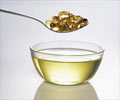• Fish oil triglycerides are available as an injectable emulsion which should be given directly into the central or peripheral vein either alone or mixed with another parenteral nutrition mixture.
• The parenteral nutrition should be mixed in the parenteral container only in aseptic conditions to avoid microbial contamination.
• Mixing of fish oil triglycerides injection with other intravenous solutions should be carefully done to avoid chemical reactions among the infusion solutions.
• The dose of dextrose and amino acids can be modified based on the contents of the fish oil triglycerides solution.
• Make sure that the parenteral mixture is free from precipitate before administration. If separation of the mixture or yellowish coloration of the solution occurs, discard the solution immediately.
• Dextrose and amino acid solution can be simultaneously added to the parenteral nutrition container followed by the fish oil triglycerides solution. The mixture can be gently shaken to make the solution uniform.
• Once the solutions are mixed, it should be given to the patient as soon as possible by using a Y-connector.
• If the mixture cannot be administered immediately, it should be stored in a refrigerator at a temperature between 2°C and 8°C for up to 24 hours or up to a maximum of 6 hours at room temperature (below 25°C).
• The infusion should be given within 24 hours from the time it is removed from its respective storage.
• The dose of fish oil triglycerides infusion can be reduced to 0.5g to 0.75g/kg body weight if the fat levels (triglycerides) are high and can be increased to a maximum 1g/kg body weight if the levels (triglycerides) are normal.
• The initial rate of infusion given within half an hour should be 0.05mL/min and can be increased to 1.5 mL/kg body weight/ in an hour if the patient is able to tolerate fish oil triglycerides without any side effects.
• The treatment with fish oil triglycerides can be stopped temporarily if any severe side effects or increased levels of triglycerides are seen in the blood.
• Choosing the correct dose of fish oil triglycerides depends on the individual patient’s energy requirements, age, body weight, tolerance level, lab values of triglycerides level, co-administration of dextrose, amino acids, and vitamin E.
• Allergic to fish oil or egg protein
• High levels of fat (cholesterol and triglycerides) in the blood
• Bleeding disorders
• Certain conditions like diabetes, stroke, occurrence of clots or fat deposits in blood vessels, and a sudden drop in blood flow or shock.
Fish oil triglycerides should not be used for preventing PNAC.
Fish oil triglycerides should not be given to premature infants, newborns, infants, children below 11 years, and patients with liver or kidney dysfunction as their safety and effectiveness have not been studied in these groups.
• The parenteral nutrition should be mixed in the parenteral container only in aseptic conditions to avoid microbial contamination.
• Mixing of fish oil triglycerides injection with other intravenous solutions should be carefully done to avoid chemical reactions among the infusion solutions.
• The dose of dextrose and amino acids can be modified based on the contents of the fish oil triglycerides solution.
• Make sure that the parenteral mixture is free from precipitate before administration. If separation of the mixture or yellowish coloration of the solution occurs, discard the solution immediately.
• Dextrose and amino acid solution can be simultaneously added to the parenteral nutrition container followed by the fish oil triglycerides solution. The mixture can be gently shaken to make the solution uniform.
• Once the solutions are mixed, it should be given to the patient as soon as possible by using a Y-connector.
• If the mixture cannot be administered immediately, it should be stored in a refrigerator at a temperature between 2°C and 8°C for up to 24 hours or up to a maximum of 6 hours at room temperature (below 25°C).
• The infusion should be given within 24 hours from the time it is removed from its respective storage.
Dosage & When it is to be taken
• The recommended daily dose of fish oil triglycerides in pediatric patients is 1g/kg body weight.• The dose of fish oil triglycerides infusion can be reduced to 0.5g to 0.75g/kg body weight if the fat levels (triglycerides) are high and can be increased to a maximum 1g/kg body weight if the levels (triglycerides) are normal.
• The initial rate of infusion given within half an hour should be 0.05mL/min and can be increased to 1.5 mL/kg body weight/ in an hour if the patient is able to tolerate fish oil triglycerides without any side effects.
• The treatment with fish oil triglycerides can be stopped temporarily if any severe side effects or increased levels of triglycerides are seen in the blood.
• Choosing the correct dose of fish oil triglycerides depends on the individual patient’s energy requirements, age, body weight, tolerance level, lab values of triglycerides level, co-administration of dextrose, amino acids, and vitamin E.
When it is not to be taken (Contraindications)
Fish oil triglycerides should not be used in patients with -• Allergic to fish oil or egg protein
• High levels of fat (cholesterol and triglycerides) in the blood
• Bleeding disorders
• Certain conditions like diabetes, stroke, occurrence of clots or fat deposits in blood vessels, and a sudden drop in blood flow or shock.
Fish oil triglycerides should not be used for preventing PNAC.
Fish oil triglycerides should not be given to premature infants, newborns, infants, children below 11 years, and patients with liver or kidney dysfunction as their safety and effectiveness have not been studied in these groups.






